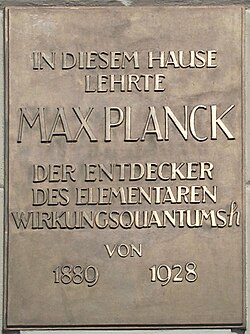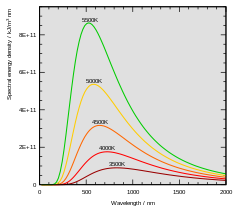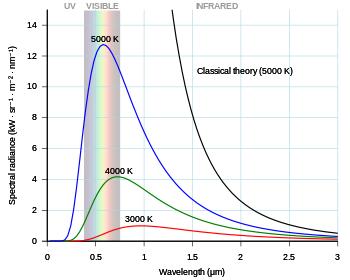The Planck constant, or Planck's constant, denoted by ,[1] is a fundamental physical constant[1] of foundational importance in quantum mechanics: a photon's energy is equal to its frequency multiplied by the Planck constant, and the wavelength of a matter wave equals the Planck constant divided by the associated particle momentum.
| Planck constant | |
|---|---|
Common symbols | |
| SI unit | joule per hertz (joule seconds) |
Other units | electronvolt per hertz (electronvolt seconds) |
| In SI base units | kg m2 s−1 |
| Dimension | |
| Value | 6.62607015×10−34 J⋅Hz−1 4.135667696...×10−15 eV⋅Hz−1 |
| Reduced Planck constant | |
|---|---|
Common symbols | |
| SI unit | joule-seconds |
Other units | electronvolt-seconds |
| In SI base units | kg m2 s−1 |
Derivations from other quantities | |
| Dimension | |
| Value | 1.054571817...×10−34 J⋅s 6.582119569...×10−16 eV⋅s |
The constant was postulated by Max Planck in 1900 as a proportionality constant needed to explain experimental black-body radiation.[2] Planck later referred to the constant as the "quantum of action".[3] In 1905, Albert Einstein associated the "quantum" or minimal element of the energy to the electromagnetic wave itself. Max Planck received the 1918 Nobel Prize in Physics "in recognition of the services he rendered to the advancement of Physics by his discovery of energy quanta".
In metrology, the Planck constant is used, together with other constants, to define the kilogram, the SI unit of mass.[4] The SI units are defined in such a way that, when the Planck constant is expressed in SI units, it has the exact value = 6.62607015×10−34 J⋅Hz−1.[5][6] It is often used with units of electronvolt (eV), which corresponds to the SI unit per elementary charge.
History
Origin of the constant


Planck's constant was formulated as part of Max Planck's successful effort to produce a mathematical expression that accurately predicted the observed spectral distribution of thermal radiation from a closed furnace (black-body radiation).[7] This mathematical expression is now known as Planck's law.
In the last years of the 19th century, Max Planck was investigating the problem of black-body radiation first posed by Kirchhoff some 40 years earlier. Every physical body spontaneously and continuously emits electromagnetic radiation. There was no expression or explanation for the overall shape of the observed emission spectrum. At the time, Wien's law fit the data for short wavelengths and high temperatures, but failed for long wavelengths.[7]: 141 Also around this time, but unknown to Planck, Lord Rayleigh had derived theoretically a formula, now known as the Rayleigh–Jeans law, that could reasonably predict long wavelengths but failed dramatically at short wavelengths.
Approaching this problem, Planck hypothesized that the equations of motion for light describe a set of harmonic oscillators, one for each possible frequency. He examined how the entropy of the oscillators varied with the temperature of the body, trying to match Wien's law, and was able to derive an approximate mathematical function for the black-body spectrum,[2] which gave a simple empirical formula for long wavelengths.
Planck tried to find a mathematical expression that could reproduce Wien's law (for short wavelengths) and the empirical formula (for long wavelengths). This expression included a constant, 
,
where 


The spectral radiance of a body, 

,
showing how radiated energy emitted at shorter wavelengths increases more rapidly with temperature than energy emitted at longer wavelengths.[12]
Planck's law may also be expressed in other terms, such as the number of photons emitted at a certain wavelength, or the energy density in a volume of radiation. The SI units of 

Planck soon realized that his solution was not unique. There were several different solutions, each of which gave a different value for the entropy of the oscillators.[2] To save his theory, Planck resorted to using the then-controversial theory of statistical mechanics,[2] which he described as "an act of desperation".[13] One of his new boundary conditions was
to interpret UN [the vibrational energy of N oscillators] not as a continuous, infinitely divisible quantity, but as a discrete quantity composed of an integral number of finite equal parts. Let us call each such part the energy element ε;
— Planck, On the Law of Distribution of Energy in the Normal Spectrum[2]
With this new condition, Planck had imposed the quantization of the energy of the oscillators, "a purely formal assumption ... actually I did not think much about it ..." in his own words,[14] but one that would revolutionize physics. Applying this new approach to Wien's displacement law showed that the "energy element" must be proportional to the frequency of the oscillator, the first version of what is now sometimes termed the "Planck–Einstein relation":
Planck was able to calculate the value of 


Development and application
The black-body problem was revisited in 1905, when Lord Rayleigh and James Jeans (on the one hand) and Albert Einstein (on the other hand) independently proved that classical electromagnetism could never account for the observed spectrum. These proofs are commonly known as the "ultraviolet catastrophe", a name coined by Paul Ehrenfest in 1911. They contributed greatly (along with Einstein's work on the photoelectric effect) in convincing physicists that Planck's postulate of quantized energy levels was more than a mere mathematical formalism. The first Solvay Conference in 1911 was devoted to "the theory of radiation and quanta".[16]
Photoelectric effect
The photoelectric effect is the emission of electrons (called "photoelectrons") from a surface when light is shone on it. It was first observed by Alexandre Edmond Becquerel in 1839, although credit is usually reserved for Heinrich Hertz,[17] who published the first thorough investigation in 1887. Another particularly thorough investigation was published by Philipp Lenard (Lénárd Fülöp) in 1902.[18] Einstein's 1905 paper[19] discussing the effect in terms of light quanta would earn him the Nobel Prize in 1921,[17] after his predictions had been confirmed by the experimental work of Robert Andrews Millikan.[20] The Nobel committee awarded the prize for his work on the photo-electric effect, rather than relativity, both because of a bias against purely theoretical physics not grounded in discovery or experiment, and dissent amongst its members as to the actual proof that relativity was real.[21][22]
Before Einstein's paper, electromagnetic radiation such as visible light was considered to behave as a wave: hence the use of the terms "frequency" and "wavelength" to characterize different types of radiation. The energy transferred by a wave in a given time is called its intensity. The light from a theatre spotlight is more intense than the light from a domestic lightbulb; that is to say that the spotlight gives out more energy per unit time and per unit space (and hence consumes more electricity) than the ordinary bulb, even though the color of the light might be very similar. Other waves, such as sound or the waves crashing against a seafront, also have their intensity. However, the energy account of the photoelectric effect did not seem to agree with the wave description of light.
The "photoelectrons" emitted as a result of the photoelectric effect have a certain kinetic energy, which can be measured. This kinetic energy (for each photoelectron) is independent of the intensity of the light,[18] but depends linearly on the frequency;[20] and if the frequency is too low (corresponding to a photon energy that is less than the work function of the material), no photoelectrons are emitted at all, unless a plurality of photons, whose energetic sum is greater than the energy of the photoelectrons, acts virtually simultaneously (multiphoton effect).[23] Assuming the frequency is high enough to cause the photoelectric effect, a rise in intensity of the light source causes more photoelectrons to be emitted with the same kinetic energy, rather than the same number of photoelectrons to be emitted with higher kinetic energy.[18]
Einstein's explanation for these observations was that light itself is quantized; that the energy of light is not transferred continuously as in a classical wave, but only in small "packets" or quanta. The size of these "packets" of energy, which would later be named photons, was to be the same as Planck's "energy element", giving the modern version of the Planck–Einstein relation:
Einstein's postulate was later proven experimentally: the constant of proportionality between the frequency of incident light 


Atomic structure

It was John William Nicholson in 1912 who introduced h-bar into the theory of the atom which was the first quantum and nuclear atom and the first to quantize angular momentum as h/2π.[24][25][26][27][28] Niels Bohr quoted him in his 1913 paper of the Bohr model of the atom.[29] The influence of the work of Nicholson's nuclear quantum atomic model on Bohr's model has been written about by many historians.[30][31][28]
Niels Bohr introduced the third quantized model of the atom in 1913, in an attempt to overcome a major shortcoming of Rutherford's classical model. The first quantized model of the atom was introduced in 1910 by Arthur Erich Haas and was discussed at the 1911 Solvay conference.[24][29] In classical electrodynamics, a charge moving in a circle should radiate electromagnetic radiation. If that charge were to be an electron orbiting a nucleus, the radiation would cause it to lose energy and spiral down into the nucleus. Bohr solved this paradox with explicit reference to Planck's work: an electron in a Bohr atom could only have certain defined energies 
where 




Bohr also introduced the quantity 


Uncertainty principle
The Planck constant also occurs in statements of Werner Heisenberg's uncertainty principle. Given numerous particles prepared in the same state, the uncertainty in their position, 

where the uncertainty is given as the standard deviation of the measured value from its expected value. There are several other such pairs of physically measurable conjugate variables which obey a similar rule. One example is time vs. energy. The inverse relationship between the uncertainty of the two conjugate variables forces a tradeoff in quantum experiments, as measuring one quantity more precisely results in the other quantity becoming imprecise.
In addition to some assumptions underlying the interpretation of certain values in the quantum mechanical formulation, one of the fundamental cornerstones to the entire theory lies in the commutator relationship between the position operator 

where 
Photon energy
The Planck relation connects the particular photon energy E with its associated wave frequency f:
This energy is extremely small in terms of ordinarily perceived everyday objects.
Since the frequency f, wavelength λ, and speed of light c are related by 
de Broglie wavelength
In 1923, Louis de Broglie generalized the Planck–Einstein relation by postulating that the Planck constant represents the proportionality between the momentum and the quantum wavelength of not just the photon, but the quantum wavelength of any particle. This was confirmed by experiments soon afterward. This holds throughout the quantum theory, including electrodynamics. The de Broglie wavelength λ of the particle is given by
where p denotes the linear momentum of a particle, such as a photon, or any other elementary particle.
The energy of a photon with angular frequency ω = 2πf is given by
while its linear momentum relates to
where k is an angular wavenumber.
These two relations are the temporal and spatial parts of the special relativistic expression using 4-vectors.
Statistical mechanics
Classical statistical mechanics requires the existence of h (but does not define its value).[32] Eventually, following upon Planck's discovery, it was speculated that physical action could not take on an arbitrary value, but instead was restricted to integer multiples of a very small quantity, the "[elementary] quantum of action", now called the Planck constant.[33] This was a significant conceptual part of the so-called "old quantum theory" developed by physicists including Bohr, Sommerfeld, and Ishiwara, in which particle trajectories exist but are hidden, but quantum laws constrain them based on their action. This view has been replaced by fully modern quantum theory, in which definite trajectories of motion do not even exist; rather, the particle is represented by a wavefunction spread out in space and in time.[34]: 373 Related to this is the concept of energy quantization which existed in old quantum theory and also exists in altered form in modern quantum physics. Classical physics cannot explain quantization of energy.
Dimension and value
The Planck constant has the same dimensions as action and as angular momentum. In SI units, the Planck constant is expressed with the unit joule per hertz (J⋅Hz−1) or joule-second (J⋅s).


Since 2019, the numerical value of the Planck constant has been fixed, with a finite decimal representation. This fixed value is used to define the Si unit of mass, the kilogram: "the kilogram [...] is defined by taking the fixed numerical value of h to be 6.62607015×10−34 when expressed in the unit J⋅s, which is equal to kg⋅m2⋅s−1, where the metre and the second are defined in terms of speed of light c and duration of hyperfine transition of the ground state of an unperturbed caesium-133 atom ΔνCs."[36] Technologies of mass metrology such as the Kibble balance measure refine the value of kilogram applying fixed value of the Planck constant.
Significance of the value
The Planck constant is one of the smallest constants used in physics. This reflects the fact that on a scale adapted to humans, where energies are typical of the order of kilojoules and times are typical of the order of seconds or minutes, the Planck constant is very small. When the product of energy and time for a physical event approaches the Planck constant, quantum effects dominate.[37]
Equivalently, the order of the Planck constant reflects the fact that everyday objects and systems are made of a large number of microscopic particles. For example, in green light (with a wavelength of 555 nanometres or a frequency of 540 THz) each photon has an energy E = hf = 3.58×10−19 J. That is a very small amount of energy in terms of everyday experience, but everyday experience is not concerned with individual photons any more than with individual atoms or molecules. An amount of light more typical in everyday experience (though much larger than the smallest amount perceivable by the human eye) is the energy of one mole of photons; its energy can be computed by multiplying the photon energy by the Avogadro constant, NA = 6.02214076×1023 mol−1[38], with the result of 216 kJ, about the food energy in three apples.[citation needed]
Reduced Planck constant ℏ
In many applications, the Planck constant 




Many of the most important equations, relations, definitions, and results of quantum mechanics are customarily written using the reduced Planck constant 

Because the fundamental equations look simpler when written using 



Names
The reduced Planck constant is known by many other names: the rationalized Planck constant[48]: 726 [49]: 10 [50]: - (or rationalized Planck's constant[51]: 334 [52]: ix [53]: 112 ), the Dirac constant[54]: 275 [48]: 726 [55]: xv (or Dirac's constant[56]: 148 [57]: 604 [58]: 313 ), the Dirac 





Symbols
By far the most common symbol for the reduced Planck constant is 



History
The combination 





See also
Notes
References
Citations
Sources
External links
- "The role of the Planck constant in physics" – presentation at 26th CGPM meeting at Versailles, France, November 2018 when voting took place.
- “The Planck constant and its units” – presentation at the 35th Symposium on Chemical Physics at the University of Waterloo, Waterloo, Ontario, Canada, November 3 2019.













